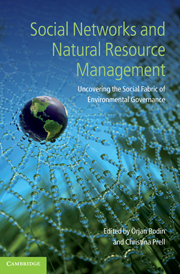 Social Networks and Natural Resource Management
Social Networks and Natural Resource Management Book contents
- Frontmatter
- Contents
- Contributors
- Foreword
- Part I Introduction
- Part II Case studies
- 4 Barriers and opportunities in transforming to sustainable governance: the role of key individuals
- 5 Social network analysis for stakeholder selection and the links to social learning and adaptive co-management
- 6 Who and how: engaging well-connected fishers in social networks to improve fisheries management and conservation
- 7 The effects of social network ties on the public’s satisfaction with forest management in British Columbia, Canada
- 8 Social network models for natural resource use and extraction
- 9 Friends or neighbors? Subgroup heterogeneity and the importance of bonding and bridging ties in natural resource governance
- 10 The role of individual attributes in the practice of information sharing among fishers from Loreto, BCS, Mexico
- 11 Transformative collective action: a network approach to transformative change in ecosystem-based management
- 12 Social networks, joint image building, and adaptability: the case of local fishery management
- 13 Agrarian communication networks: consequences for agroforestry
- Part III Summary and outlook
- Index
- References
7 - The effects of social network ties on the public’s satisfaction with forest management in British Columbia, Canada
from Part II - Case studies
Published online by Cambridge University Press: 05 June 2012
- Frontmatter
- Contents
- Contributors
- Foreword
- Part I Introduction
- Part II Case studies
- 4 Barriers and opportunities in transforming to sustainable governance: the role of key individuals
- 5 Social network analysis for stakeholder selection and the links to social learning and adaptive co-management
- 6 Who and how: engaging well-connected fishers in social networks to improve fisheries management and conservation
- 7 The effects of social network ties on the public’s satisfaction with forest management in British Columbia, Canada
- 8 Social network models for natural resource use and extraction
- 9 Friends or neighbors? Subgroup heterogeneity and the importance of bonding and bridging ties in natural resource governance
- 10 The role of individual attributes in the practice of information sharing among fishers from Loreto, BCS, Mexico
- 11 Transformative collective action: a network approach to transformative change in ecosystem-based management
- 12 Social networks, joint image building, and adaptability: the case of local fishery management
- 13 Agrarian communication networks: consequences for agroforestry
- Part III Summary and outlook
- Index
- References
Summary
Introduction
In the past several decades there has been a growing interest in the human/social dimensions of forestry and other natural resource industries. In the past several years a specific interest in the role of social networks in these domains has arisen (Hubacek et al., 2006, Prell et al., 2009). There are many possible ways in which social networks might be important to societies/communities and natural resources. Communities themselves can be thought of as social networks (Wellman, 1979). Networks play an important role in diffusing information (Coleman et al., 1966). Beliefs, values, and attitudes are formed partly in the context of network structures (Erickson, 1988; Harshaw and Tindall, 2005). Individuals are connected to one another through organizations (Breiger, 1974) in what are sometimes called two-mode networks. Political economists sometimes look at interorganizational ties, and the ways in which business leaders are linked through interlocking directorships (Carroll, 2004). Collective actions and social movements usually have a network basis (Diani and McAdam, 2003). Network analysts have examined the role of social networks in environmental movements that have arisen vis-à-vis various environmental and natural resource issues (Diani, 1995; Tindall, 2002, 2004).
- Type
- Chapter
- Information
- Social Networks and Natural Resource ManagementUncovering the Social Fabric of Environmental Governance, pp. 147 - 179Publisher: Cambridge University PressPrint publication year: 2011
References
- 4
- Cited by


